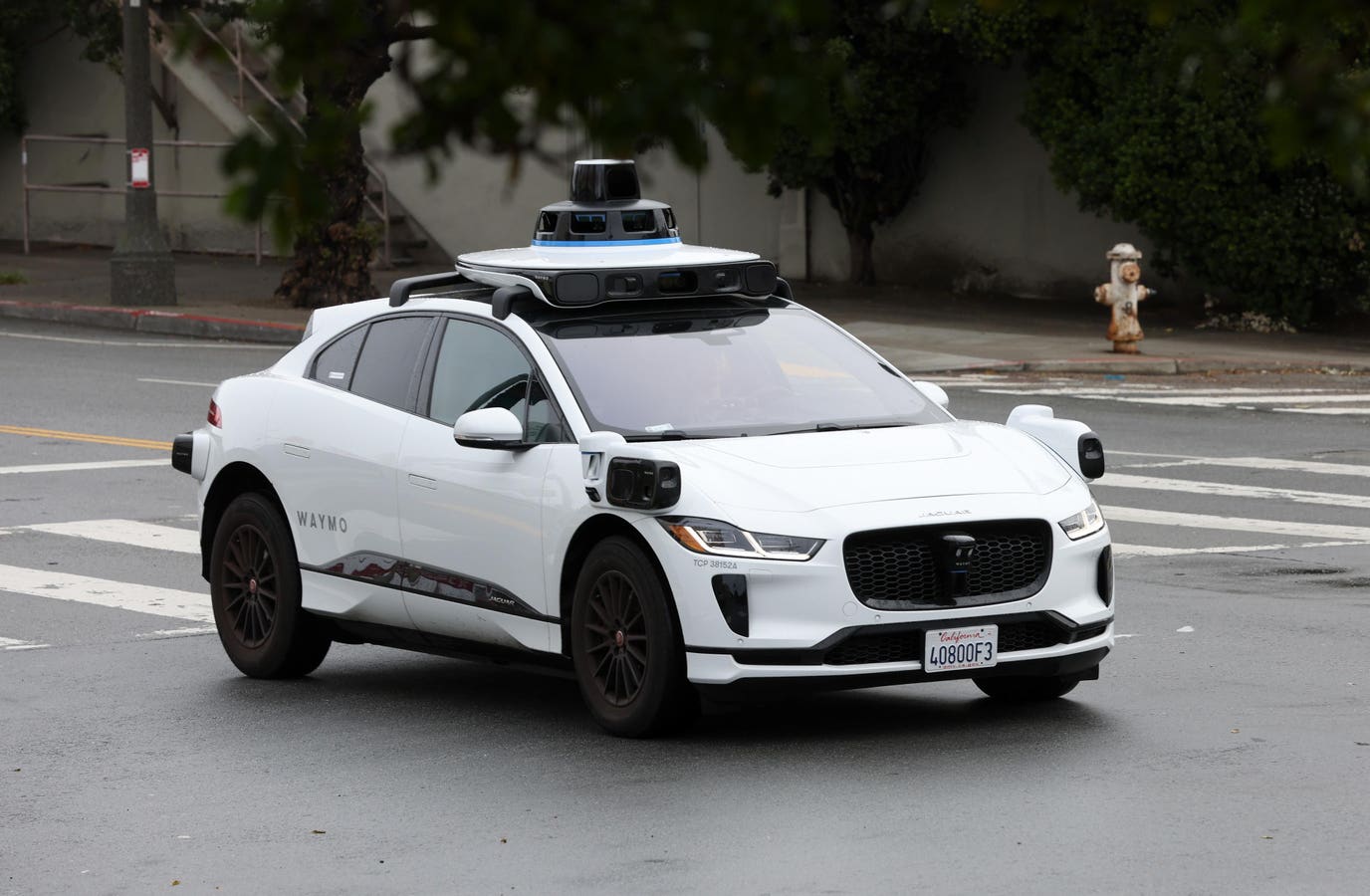Autonomous vehicles (AVs) are no longer a distant prospect. In cities like San Francisco, Phoenix, and Austin, robotaxis are already operating on public streets, offering a glimpse of a future that is arriving faster than many expected. Companies like Waymo are expanding their fleets, while Uber and others are investing heavily in automation, accelerating the race to transform urban mobility. This weekend, Tesla also launched its first autonomous service in Austin, signaling growing competition in the sector. For cities, the moment is both a challenge and an opportunity: how to prepare for the AV future in a way that maximizes benefits while minimizing unintended consequences.
SAN FRANCISCO, CALIFORNIA – APRIL 11: A Waymo autonomous vehicle drives along Masonic Avenue on … More
The Promise of Autonomous Vehicles
If deployed thoughtfully, AVs hold the potential to make transportation safer, more efficient, and more sustainable. Human error is responsible for over 90% of traffic fatalities—AVs could dramatically reduce collisions and save lives. By enabling more precise traffic flow and reducing the need for parking, AVs could help cities reclaim space for housing, green infrastructure, or active transportation.
Autonomous technology also opens new possibilities for improving access. AVs can expand mobility options for people who cannot drive—such as the elderly or people with disabilities—and serve as flexible first/last-mile connectors in transit deserts. When combined with electrification and pooling, AVs could reduce emissions and support cities’ climate goals.
The Risks of a Hands-Off Approach
Yet, the risks are real. A report from the National Association of City Transportation Officials (NACTO) warns that, left unchecked, AVs could increase vehicle miles traveled (VMT), further congest streets, and undermine public transit. The National League of Cities has also raised concerns about private AVs outpacing the regulatory ability of cities to manage them effectively. Without guardrails, the AV future could replicate—and even worsen—today’s challenges.
A Rapidly Shifting Market
In San Francisco, Waymo has emerged as the dominant player in the AV space. Their services are estimated to account for more than 27% of ridehailing trips in the city — more than Lyft, and rapidly eating into Uber’s market share. The company has surpassed 10 million paid rides and delivers approximately 250,000 driverless trips weekly across its service areas, including recent expansions into Los Angeles, Austin, and parts of Silicon Valley.
Meanwhile, other major players are preparing to enter the autonomous ride-hailing market. Tesla, for instance, is planning the broader launch of its “CyberCab” robotaxi service, with early testing and limited rollout beginning this year. The arrival of new entrants will likely accelerate competition and intensify pressure on cities to modernize their regulatory frameworks.
This rapid scaling of AV deployments signals the urgent need for cities to prepare. Parking authorities, in particular, will need to reexamine their policies as curb usage fundamentally shifts from long-term parking to dynamic pick-up and drop-off zones. Traditional metered parking models may no longer apply in a world where vehicles don’t park but circulate. Cities must proactively redesign curb management strategies to accommodate these changes while ensuring equitable access and efficient traffic flow.
Los Angeles, CA – March 11: (EDS NOTE-NEWS EMBARGO UNTIL WEDNESDAY) A Waymo robotaxi Jaguar I-PACEs … More
Policy Levers Cities Can Use
Despite the pace of innovation, cities are not powerless. While the AV hardware and software are driven by private investment, the rules of the road are local. Cities can and must use their authority over streets, curbs, and zoning to shape AV deployment in the public interest.
Key strategies include:
- Curb Management: AVs will increase demand for curb space as they pick up and drop off passengers. Smart curb policies—like prioritizing high-occupancy and zero-emission vehicles—can prevent gridlock and improve safety.
- Data Sharing Requirements: Cities need data from AV operators to evaluate performance, ensure accountability, and update policies. Standardized, anonymized data-sharing frameworks such as the Mobility Data Specification (MDS) are essential.
- Incentives for Electrification and Pooling: Cities should align AV permits and pricing structures with their sustainability goals, rewarding fleets that are both electric and shared.
- Integration with Transit: AVs should serve as a complement to, not a replacement for, public transportation. Cities can incentivize service models that improve access to transit, particularly in underserved neighborhoods.
- Parking Policy Reform: With fewer drivers needing to park, cities can rethink their parking infrastructure, repurposing on-street and garage space for housing, commercial use, or green space.
Learning from Early Deployment Cities
San Francisco’s experience with AVs has been both promising and contentious. While some residents have raised concerns about safety and disruptions, others have embraced the convenience and innovation. Importantly, the city’s experience underscores the need for clear oversight, transparent communication, and ongoing public engagement.
Other cities—including Pittsburgh, Boston, and Los Angeles—are taking proactive steps to prepare. They are forming AV task forces, developing deployment principles, and engaging community members. These early adopters are creating roadmaps that others can follow, with a focus on equity, sustainability, and accountability.
Preparing for What’s Next
The AV race is well underway, and cities that delay action risk being caught flat-footed. By contrast, cities that lead with purpose can shape how AVs contribute to their broader transportation, climate, and equity goals.
To prepare, cities should:
- Create clear AV policy frameworks grounded in public values
- Invest in digital and physical infrastructure to manage AV operations
- Build staff capacity and expertise to evaluate AV data and performance
- Coordinate across jurisdictions to align standards and reduce regulatory fragmentation
- Leverage data-sharing agreements—through incentives or mandates—to gain visibility into AV operations and ensure outcomes align with public goals
Autonomous vehicles offer a rare chance to reimagine mobility from the ground up. They can help cities reduce traffic deaths, lower emissions, and improve access—if the right policies are in place.
Innovation alone won’t guarantee progress. But with leadership, planning, and a clear vision, AVs can help cities build a safer, greener, and more inclusive transportation future.









